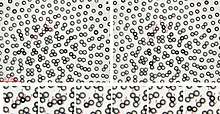Droplet cluster






Droplet cluster is a self-assembled levitating monolayer of microdroplets usually arranged into a hexagonally ordered structure over a locally heated thin (about 1 mm) layer of water. The droplet cluster is typologically similar to
Growing condensing
Due to complex nature of
By controlling the temperature and temperature gradient one can control the number of droplets and their density and size. Using infrared irradiation, it is possible to suppress droplet growth and stabilize them for extended periods of time.[6]
It has been suggested that the phenomenon, when combined with a spectrographic study of droplets content, can be used for rapid biochemical in situ analysis.[7] Recent studies have shown that the cluster can exist at lower temperatures of about 20 °C, which makes it suitable for biochemical analysis of living objects.[4]
Clusters with an arbitrary small number of droplets can be created. Unlike the clusters with a large number of droplets, small clusters cannot always form a hexagonally symmetric structure. Instead, they produce various more or less symmetric configurations depending on the number of droplets. Tracing individual droplets in small clusters is crucial for potential applications. The symmetry, orderliness, and stability of these configurations can be studied with such a measure of self-organization as the Voronoi entropy.[8]
Since the most common hexagonal (honeycomb shaped) droplet cluster was observed for the first time in 2004, new types of types of levitating droplet clusters were discovered. In a chain droplet cluster, rotating droplets may be very close to each other but viscosity of the thin gas layer between the droplets prevents them from coalescing. There is a reversible structural transition from the ordered hexagonal cluster to the chain-like structure.
The phenomenon of the droplet cluster is different from the Leidenfrost effect because the latter occurs at much higher temperatures over a solid surface, while the droplet cluster forms at lower temperatures over a liquid surface. The phenomenon has also been observed with liquids other than water.
See also
- Leidenfrost effect
- Rayleigh–Bénard convection
- Self assembly
